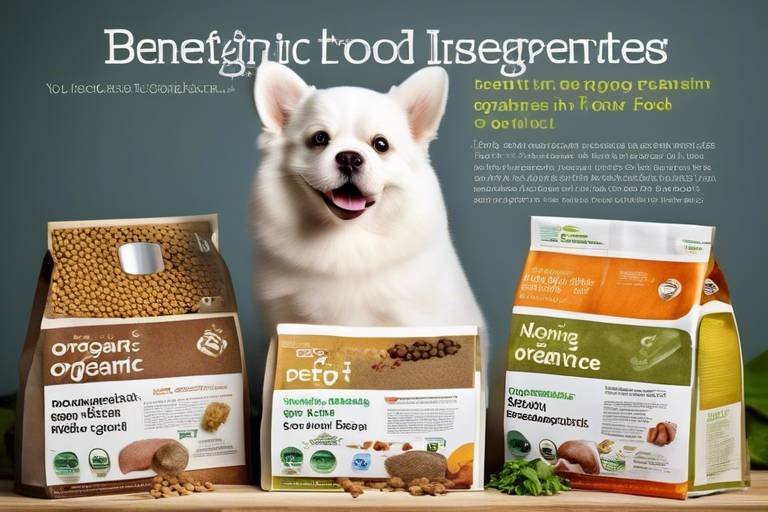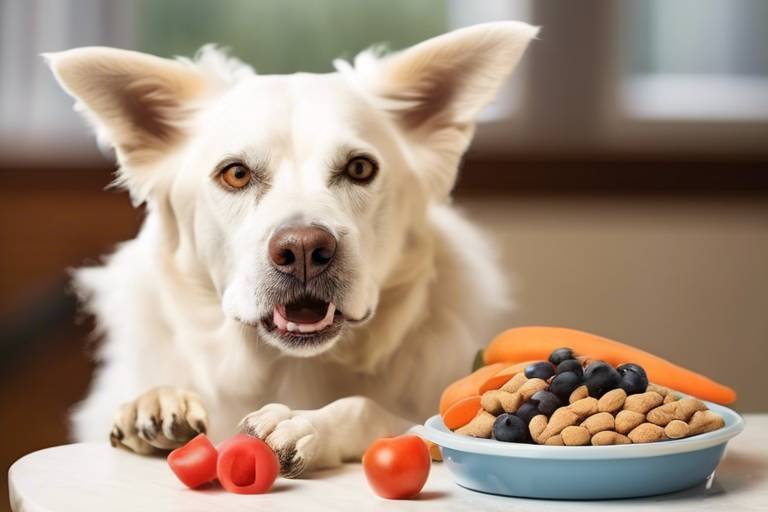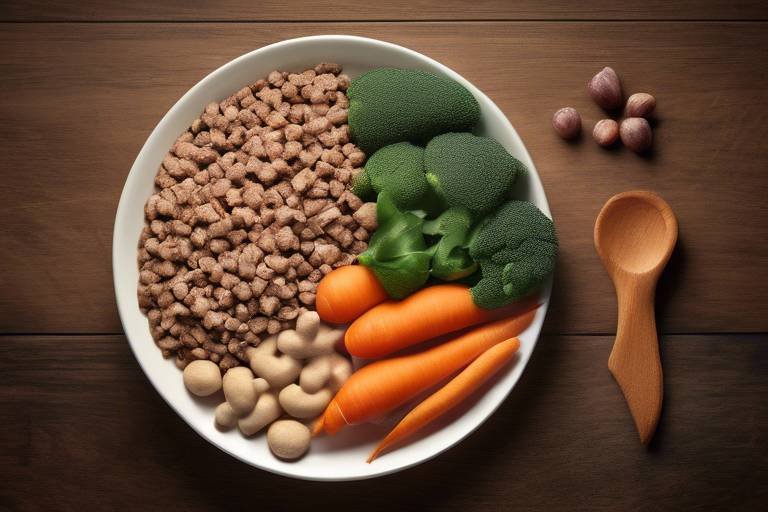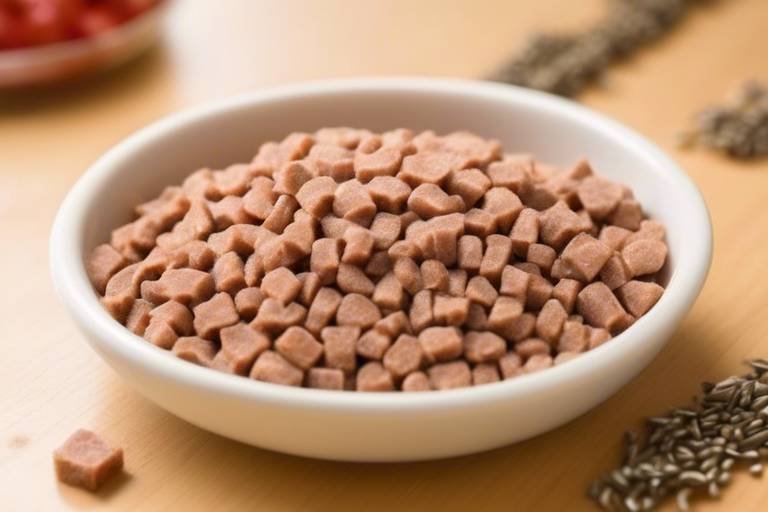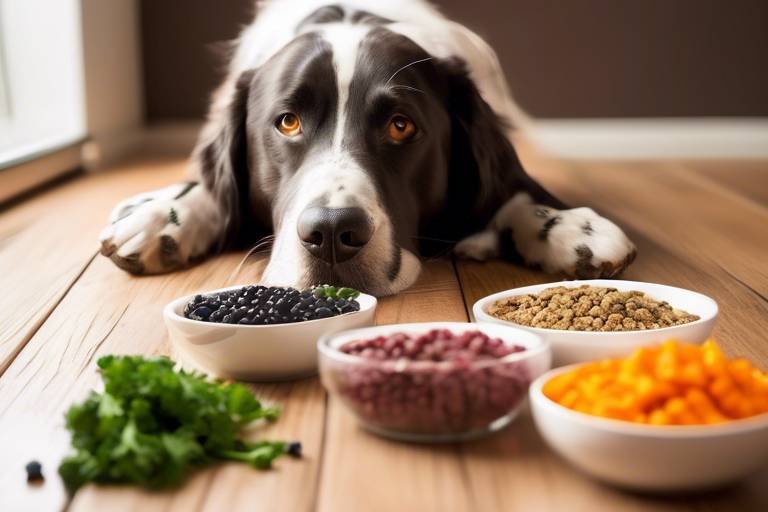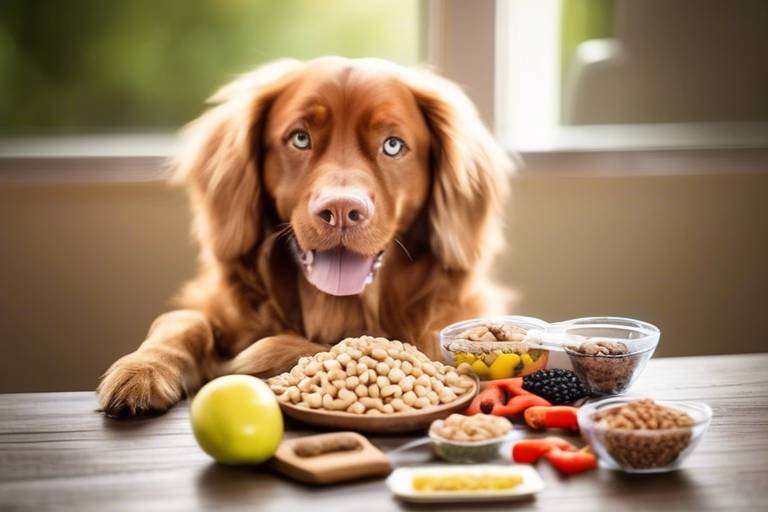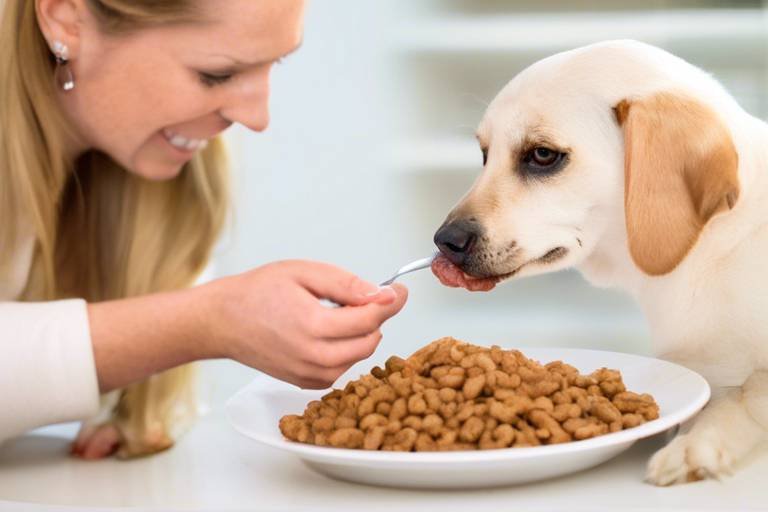How to Choose the Right Pet Food for Your Dog
Choosing the right pet food for your dog is more than just picking a bag off the shelf; it’s about ensuring your furry friend gets the **best nutrition** tailored to their unique needs. With so many options available, the process can feel overwhelming. However, understanding your dog’s nutritional requirements and the different types of food can make this decision easier and more rewarding. This article will guide you through the essential factors to consider, so your dog can thrive and enjoy a healthy, happy life.
Just like humans, dogs have specific dietary requirements that vary based on their age, size, and activity level. For instance, a **puppy** needs different nutrients than an **older dog**. Recognizing these needs is crucial to providing a balanced diet that supports their overall health and vitality. A dog’s diet should include a mix of proteins, fats, carbohydrates, vitamins, and minerals. Think of it like building a house; without a solid foundation, everything else can crumble. The right dog food acts as that foundation, supporting everything from energy levels to immune function.
When it comes to dog food, you’ll find various types, each with its own benefits and drawbacks. Here’s a quick rundown:
- Dry Dog Food: Convenient and shelf-stable, dry food is a popular choice among pet owners.
- Wet Dog Food: Higher in moisture, wet food can be more appealing to picky eaters.
- Raw Dog Food: Some owners opt for raw diets, believing they mimic a dog’s ancestral diet.
- Homemade Dog Food: Preparing meals at home allows for complete control over ingredients.
Each type has its pros and cons, making it essential to choose wisely based on your dog’s specific needs and preferences.
Dry dog food, often referred to as kibble, is a popular choice for many pet owners. It’s convenient, easy to store, and generally more affordable than wet food. The crunchy texture of kibble can also help maintain dental health, acting like a toothbrush to scrape away plaque. However, it’s crucial to select high-quality brands that offer optimal nutrition. Look for brands that use real meat as the first ingredient and avoid those with fillers and artificial additives. After all, would you want to eat something that’s mostly made up of **fillers**?
Dry food comes with several advantages:
- Affordability: Generally less expensive than other types of food.
- Storage: Easy to store without refrigeration.
- Dental Health: Crunchy texture helps reduce plaque buildup.
While dry food is convenient, it may lack moisture, which is vital for hydration. Dogs who primarily eat dry food may not drink enough water, leading to potential health issues. It’s essential to assess your dog’s overall health and hydration before making it their primary diet.
Wet dog food is another popular option, especially for dogs that are picky eaters. With its higher moisture content, it can make mealtime more enticing. However, wet food often comes at a higher price and has a shorter shelf life once opened. If you decide to go this route, consider mixing it with dry food to balance cost and nutrition.
Understanding pet food labels is vital for making informed decisions. Learning how to interpret ingredients and nutritional information ensures you choose the best food for your dog. When you pick up a bag of dog food, take a moment to look beyond the flashy packaging and marketing claims. What’s really inside?
Identifying high-quality protein sources and wholesome ingredients is essential. Look for real meat as the first ingredient and avoid fillers and artificial additives. A good rule of thumb is to avoid ingredients you can’t pronounce. If it sounds like a chemistry experiment, it probably doesn’t belong in your dog’s bowl!
Many pet foods contain misleading marketing claims. Be wary of terms like “natural” or “premium,” which can be vague. Always check the ingredient list and nutritional analysis to ensure you’re not falling for clever advertising. Remember, your dog relies on you to make the right choices for their health.
Your veterinarian can provide personalized recommendations based on your dog's health, age, and dietary needs. Regular consultations ensure your pet receives the best nutritional guidance. Think of your vet as your dog’s nutrition coach, helping you navigate the often-confusing world of pet food.
Routine veterinary visits are essential for monitoring your dog's health and adjusting their diet as necessary. Just like we need regular check-ups to stay healthy, our pets do too! Keeping track of their nutritional needs is crucial for long-term wellness.
As dogs age or their health changes, their dietary requirements may shift. Understanding when and how to adjust their food can help maintain their health and energy levels. For example, an older dog may require a diet lower in calories but higher in fiber. Staying attuned to these changes ensures a happy and healthy pet.
When changing your dog's food, a gradual transition is important to avoid digestive upset. Just like us, dogs can have sensitive stomachs, and a sudden change can lead to discomfort. Learning the best practices for introducing new food can make the switch smoother.
Follow this structured plan for transitioning your dog to new food:
- Start by mixing a small amount of the new food with their current food.
- Gradually increase the proportion of new food over a week.
- Monitor your dog’s response and adjust as necessary.
Observing your dog's behavior and health during the transition is crucial. Watch for signs of intolerance or allergies, such as vomiting or diarrhea. If you notice any adverse reactions, consult your veterinarian for further adjustments in their diet.
Some pet owners prefer preparing homemade dog food. This option allows for complete control over ingredients, ensuring your dog receives fresh and wholesome nutrition. However, understanding the nutritional balance required for homemade diets is vital. Just because it’s homemade doesn’t mean it’s automatically healthy!
Homemade dog food can provide fresher ingredients and tailored nutrition. You can cater to your dog's specific preferences and dietary restrictions. However, it’s essential to do thorough research to ensure all dietary needs are met. Think of it as crafting a gourmet meal for your beloved pet!
While homemade diets can be beneficial, they also pose risks if not properly balanced. Consulting with a veterinarian or pet nutritionist is recommended to avoid deficiencies. Just like we need a balanced diet, so do our pets!
Choosing the right pet food for your dog involves understanding their unique needs, evaluating food options, and consulting with professionals. A well-informed decision leads to a happier, healthier pet. After all, our dogs depend on us to provide them with the nutrition they need to thrive. So, the next time you’re at the pet store, take a moment to consider what’s in that bag. Your dog will thank you for it!
Common signs of food allergies in dogs include itching, gastrointestinal upset, and skin irritations. If you suspect your dog has a food allergy, consult your veterinarian for advice.
Yes, you can mix dry and wet food, but make sure to adjust the portions to maintain a balanced diet. Always monitor your dog's reaction to the new combination.
It's generally not necessary to change your dog's food frequently. However, if your dog’s health needs change, consult your vet for recommendations.
Homemade dog food can be beneficial, but it must be well-balanced to meet all nutritional needs. Always consult a veterinarian or pet nutritionist before making the switch.

Understanding Dog Nutritional Needs
When it comes to our furry friends, understanding their nutritional needs is paramount. Just like humans, dogs have specific dietary requirements that vary based on several factors, including their age, size, and activity level. For instance, a puppy has different nutritional needs compared to a senior dog. Puppies require higher protein and fat levels to support their rapid growth, while older dogs might need a diet lower in calories to avoid obesity. This means that choosing the right food can be a bit like solving a puzzle—every piece must fit perfectly for optimal health and vitality.
Additionally, the size of your dog plays a significant role in their dietary needs. Small breeds, like Chihuahuas, may require more calorie-dense food due to their fast metabolism, while large breeds, like Great Danes, need a diet that supports their massive frame without promoting rapid growth, which can lead to health issues. Understanding these nuances can help you make informed choices that cater to your dog's unique requirements.
Activity level is another crucial factor. An active dog, such as a working breed or one that regularly participates in agility training, will need more calories and nutrients than a couch potato pup. It's essential to assess how much exercise your dog gets on a daily basis to adjust their food intake accordingly. A dog that leads a sedentary lifestyle might require a lower-calorie diet to prevent weight gain, while an active dog might benefit from higher protein and fat content to fuel their energy needs.
To put it simply, choosing the right dog food is not a one-size-fits-all approach. Here are some key points to consider:
- Age: Puppies, adults, and seniors have different dietary requirements.
- Size: Small, medium, and large breeds need tailored nutrition.
- Activity Level: Active dogs require more calories and nutrients.
In summary, understanding your dog's nutritional needs is the first step towards ensuring they live a long, healthy life. By taking the time to assess their age, size, and activity level, you can make informed decisions that will keep their tails wagging and their hearts happy.
1. How do I know what type of food is best for my dog?
It's essential to consider your dog's age, size, and activity level when selecting food. Consulting with your veterinarian can provide personalized recommendations tailored to your dog's specific needs.
2. Can I feed my dog homemade food?
Yes, but it's crucial to ensure that the homemade diet is balanced and meets all of your dog's nutritional requirements. Consulting with a veterinarian or pet nutritionist is highly recommended.
3. How can I tell if my dog is getting the right nutrition?
A healthy dog typically has a shiny coat, clear eyes, and a good energy level. Regular veterinary check-ups can help monitor your dog's health and make necessary dietary adjustments.
4. Is it okay to switch my dog's food frequently?
Frequent changes in diet can upset your dog's stomach. It's best to transition gradually and stick to a consistent diet unless advised otherwise by a veterinarian.

Types of Dog Food
When it comes to feeding your furry friend, understanding the available is essential for making the right choice. There are various options, each with its own set of benefits and drawbacks. The most common types include dry food, wet food, raw food, and homemade diets. Each of these categories caters to different needs and preferences, so let's dive deeper into what each option offers.
Dry dog food, often referred to as kibble, is one of the most popular choices among pet owners. Its convenience is unmatched; it can be easily stored, is generally more affordable, and has a long shelf life. The crunchy texture of kibble can also help in maintaining your dog's dental health by reducing plaque buildup. However, it’s crucial to select high-quality brands that prioritize nutrition over fillers. Remember, not all kibble is created equal!
One of the main advantages of dry food is its cost-effectiveness. You can purchase it in bulk, which often leads to savings. Additionally, the texture can promote better dental hygiene, as the crunchiness helps to scrape off plaque. Many pet owners appreciate the convenience of measuring portions and the ease of serving. Plus, there’s a wide variety of flavors and formulas available to cater to different dietary needs.
Despite its benefits, dry food does have its downsides. The lack of moisture can be a concern, especially for dogs that might not drink enough water. This is particularly important for certain breeds that are prone to urinary tract issues. Therefore, assessing your dog’s overall health and hydration needs is essential before making dry food their primary diet.
Wet dog food is another popular option, especially for picky eaters. The higher moisture content makes it more palatable and can be beneficial for dogs that struggle with hydration. However, it tends to be more expensive and has a shorter shelf life once opened. Wet food can be a great addition to a dog’s diet, particularly when mixed with dry kibble to create a balanced meal.
Raw diets have gained popularity in recent years, with many pet owners advocating for a more natural approach to canine nutrition. These diets typically consist of raw meat, bones, fruits, and vegetables. Proponents argue that a raw diet can lead to healthier skin, shinier coats, and improved digestion. However, it’s essential to do thorough research and consult with a veterinarian before transitioning to a raw food diet, as improper handling and preparation can lead to health risks.
Some pet owners prefer to prepare homemade dog food, believing it allows for greater control over ingredients and nutrition. Homemade diets can provide fresher ingredients, tailored nutrition, and the ability to cater to specific allergies or health issues. However, it’s crucial to ensure that these diets are well-balanced and meet all of your dog’s nutritional needs. Consulting with a veterinarian or a pet nutritionist is highly recommended to avoid deficiencies.
In conclusion, the type of dog food you select can significantly impact your pet's health and happiness. Whether you opt for dry, wet, raw, or homemade food, it’s essential to consider your dog’s individual needs and preferences. Always prioritize high-quality ingredients and consult with professionals to ensure your furry friend is getting the best nutrition possible.
- What is the best type of dog food? The best type varies based on your dog's age, size, and health. Consult your veterinarian for personalized recommendations.
- Can I mix dry and wet food? Yes! Mixing dry and wet food can provide a balanced diet and increase palatability for picky eaters.
- How do I know if my dog is allergic to their food? Look for signs like itching, digestive issues, or changes in behavior. Consult your vet if you suspect an allergy.
- Is homemade dog food safe? Homemade diets can be safe, but they must be well-balanced. Always consult a vet or pet nutritionist before switching.
Dry Dog Food
This article explores essential factors to consider when selecting dog food, ensuring your pet receives the best nutrition tailored to their needs for optimal health and well-being.
Dogs have specific dietary requirements based on their age, size, and activity level. Recognizing these needs is crucial to providing a balanced diet that supports their overall health and vitality.
There are various types of dog food available, including dry, wet, raw, and homemade options. Each type has its own benefits and drawbacks, making it important to choose wisely.
Dry dog food, often referred to as kibble, is one of the most popular choices among pet owners. Its convenience and long shelf life make it an attractive option for busy lifestyles. Plus, the crunchy texture of kibble can help maintain your dog's dental health by reducing plaque buildup. However, not all dry dog foods are created equal, and it's essential to select high-quality brands that prioritize nutrition.
When considering dry dog food, keep in mind the following benefits:
- Cost-Effective: Dry food is generally more affordable than wet food, making it a budget-friendly option for many pet owners.
- Easy Storage: Kibble can be stored easily without the need for refrigeration, which is a significant advantage for those with limited storage space.
- Dental Health: The texture of dry food can promote better oral hygiene by helping to clean your dog's teeth as they chew.
However, while dry food has its advantages, it also comes with potential drawbacks. One of the main concerns is its lack of moisture. Dogs, especially those who may not drink enough water, can benefit from the hydration that wet food provides. Additionally, some low-quality dry foods may contain fillers and artificial additives that do not contribute to your dog's nutritional needs.
Before choosing dry food as your dog's primary diet, it's essential to assess their overall health and hydration needs. Consulting with your veterinarian can provide valuable insights into which type of food is best suited for your furry friend.
Understanding pet food labels is essential for making informed decisions. Learning how to interpret ingredients and nutritional information ensures you choose the best food for your dog.
Identifying high-quality protein sources and wholesome ingredients is vital. Look for real meat as the first ingredient and avoid fillers and artificial additives for better nutrition.
Many pet foods contain misleading marketing claims. Being aware of common pitfalls, such as vague ingredient lists, can help you avoid low-quality options.
Your veterinarian can provide personalized recommendations based on your dog's health, age, and dietary needs. Regular consultations ensure your pet receives the best nutritional guidance.
Routine veterinary visits are essential for monitoring your dog's health and adjusting their diet as necessary. Keeping track of their nutritional needs is crucial for long-term wellness.
As dogs age or their health changes, their dietary requirements may shift. Understanding when and how to adjust their food can help maintain their health and energy levels.
When changing your dog's food, a gradual transition is important to avoid digestive upset. Learn the best practices for introducing new food to ensure a smooth switch.
Following a structured plan for transitioning can help your dog adapt to new food without gastrointestinal issues. Gradual changes promote better acceptance and digestion.
Observing your dog's behavior and health during the transition is crucial. Signs of intolerance or allergies may indicate the need for further adjustments in their diet.
Some pet owners prefer preparing homemade dog food. Understanding the nutritional balance required for homemade diets is vital to ensure your dog receives all necessary nutrients.
Homemade dog food can provide fresher ingredients and tailored nutrition. However, it's essential to do thorough research to ensure all dietary needs are met.
While homemade diets can be beneficial, they also pose risks if not properly balanced. Consulting with a veterinarian or pet nutritionist is recommended to avoid deficiencies.
Choosing the right pet food for your dog involves understanding their unique needs, evaluating food options, and consulting with professionals. A well-informed decision leads to a happier, healthier pet.
1. How do I know if I'm choosing the right food for my dog?
It's essential to consider your dog's age, size, activity level, and any specific health concerns. Consulting with your veterinarian can provide tailored advice.
2. Can I mix dry and wet dog food?
Yes, many pet owners choose to mix dry and wet food to provide variety and enhance palatability. Just ensure that the combined diet meets your dog's nutritional needs.
3. How long should I transition my dog to a new food?
A gradual transition over 7 to 10 days is recommended to minimize digestive upset. Start by mixing a small amount of the new food with the old and gradually increase the new food's proportion.
4. Are homemade diets safe for dogs?
Homemade diets can be safe if balanced correctly. It's crucial to consult with a veterinarian or a pet nutritionist to ensure that all nutritional requirements are met.
Benefits of Dry Food
This article explores essential factors to consider when selecting dog food, ensuring your pet receives the best nutrition tailored to their needs for optimal health and well-being.
Dogs have specific dietary requirements based on their age, size, and activity level. Recognizing these needs is crucial to providing a balanced diet that supports their overall health and vitality.
There are various types of dog food available, including dry, wet, raw, and homemade options. Each type has its own benefits and drawbacks, making it important to choose wisely.
Dry dog food, or kibble, is convenient and shelf-stable. Its crunchy texture can help maintain dental health, but it’s essential to select high-quality brands for optimal nutrition.
When it comes to feeding your furry friend, dry dog food offers a multitude of advantages that can make it a great choice for many pet owners. One of the most significant benefits is its affordability. Compared to wet food, dry kibble is often more budget-friendly, making it easier to keep your dog well-fed without breaking the bank.
Another advantage is the convenience it provides. Dry food can be stored easily, has a longer shelf life, and is less messy than wet food. Imagine not having to deal with sticky cans or worrying about leftovers spoiling quickly! Plus, the crunchiness of kibble can help to promote dental health by reducing plaque and tartar buildup as your dog chews.
Here are some additional benefits of dry dog food:
- Portion Control: It's easier to measure out precise portions with dry food, which can help prevent overfeeding.
- Less Waste: Since dry food has a longer shelf life, you won’t have to worry about wasting food that goes bad.
- Variety: Many brands offer a wide range of flavors and formulations, allowing you to choose the best option for your dog's specific needs.
However, it’s essential to choose high-quality brands that use real meat and wholesome ingredients. Not all dry foods are created equal, so be sure to do your research and read labels carefully. Selecting premium dry food can ensure your dog gets the nutrients they need to thrive.
While dry food is convenient, it may lack moisture, which is vital for hydration. Assessing your dog’s overall health is necessary before making it their primary diet.
Wet dog food offers higher moisture content, making it appealing for picky eaters. However, it can be more expensive and has a shorter shelf life.
Understanding pet food labels is essential for making informed decisions. Learning how to interpret ingredients and nutritional information ensures you choose the best food for your dog.
Identifying high-quality protein sources and wholesome ingredients is vital. Look for real meat as the first ingredient and avoid fillers and artificial additives for better nutrition.
Many pet foods contain misleading marketing claims. Being aware of common pitfalls, such as vague ingredient lists, can help you avoid low-quality options.
Your veterinarian can provide personalized recommendations based on your dog's health, age, and dietary needs. Regular consultations ensure your pet receives the best nutritional guidance.
Routine veterinary visits are essential for monitoring your dog's health and adjusting their diet as necessary. Keeping track of their nutritional needs is crucial for long-term wellness.
As dogs age or their health changes, their dietary requirements may shift. Understanding when and how to adjust their food can help maintain their health and energy levels.
When changing your dog's food, a gradual transition is important to avoid digestive upset. Learn the best practices for introducing new food to ensure a smooth switch.
Following a structured plan for transitioning can help your dog adapt to new food without gastrointestinal issues. Gradual changes promote better acceptance and digestion.
Observing your dog's behavior and health during the transition is crucial. Signs of intolerance or allergies may indicate the need for further adjustments in their diet.
Some pet owners prefer preparing homemade dog food. Understanding the nutritional balance required for homemade diets is vital to ensure your dog receives all necessary nutrients.
Homemade dog food can provide fresher ingredients and tailored nutrition. However, it's essential to do thorough research to ensure all dietary needs are met.
While homemade diets can be beneficial, they also pose risks if not properly balanced. Consulting with a veterinarian or pet nutritionist is recommended to avoid deficiencies.
Choosing the right pet food for your dog involves understanding their unique needs, evaluating food options, and consulting with professionals. A well-informed decision leads to a happier, healthier pet.
- How often should I feed my dog? Most dogs do well with two meals a day, but consult your vet for personalized advice.
- Can I mix dry and wet food? Yes, many pet owners do this to provide variety and enhance flavor.
- What should I do if my dog is picky with food? Try different flavors or brands, and consult your vet if the issue persists.
Potential Drawbacks
While dry dog food is a popular choice among pet owners due to its convenience and affordability, it's important to consider some potential drawbacks that could affect your dog's health. One significant concern is the lack of moisture in dry kibble. Dogs, like humans, require adequate hydration to maintain optimal health, and a diet consisting solely of dry food might not provide enough moisture. This can lead to dehydration, especially for dogs that do not drink enough water.
Another issue to consider is the quality of ingredients used in some dry dog foods. Not all brands are created equal, and some may contain low-quality fillers, artificial preservatives, and by-products that do not contribute to your dog's nutritional needs. It's crucial to research and select high-quality brands that prioritize real meat and wholesome ingredients as their primary components.
Moreover, some dogs may experience digestive issues when transitioning to a dry food diet, especially if they are used to wet food or a homemade diet. This can manifest as gastrointestinal upset, leading to symptoms like vomiting or diarrhea. To mitigate this, a gradual transition is recommended, allowing your dog’s digestive system to adjust to the new diet.
Lastly, the palatability of dry food can be a concern for picky eaters. Some dogs may not find dry kibble as appealing as wet food, which could lead to decreased appetite and, subsequently, nutritional deficiencies if they refuse to eat. If your dog is particularly finicky, it might be worth exploring other options or mixing dry food with wet food to enhance flavor and texture.
- Can I mix dry food with wet food? Yes, mixing dry food with wet food can make it more palatable for picky eaters and help increase moisture intake.
- How can I tell if my dog is dehydrated? Signs of dehydration in dogs include dry gums, lethargy, and decreased skin elasticity. If you notice these symptoms, consult your veterinarian.
- Is all dry dog food the same? No, the quality of dry dog food can vary significantly between brands. Always check the ingredient list and look for high-quality sources of protein.
- How do I transition my dog to a new dry food? Gradually mix the new food with the old food over a week, slowly increasing the proportion of the new food to minimize digestive upset.
Wet Dog Food
When it comes to feeding your furry friend, can be a game-changer. This type of food typically comes in cans or pouches and is packed with moisture, making it an excellent choice for dogs that may not drink enough water throughout the day. The high moisture content not only helps keep your dog hydrated but also adds a burst of flavor that can entice even the pickiest eaters. Imagine your dog’s tail wagging with excitement as they dig into a savory meal that smells as good as it tastes!
However, while wet dog food has its perks, there are some considerations to keep in mind. For starters, it tends to be more expensive than dry kibble, which can add up over time, especially if you have a larger breed or multiple dogs. Additionally, wet food generally has a shorter shelf life once opened, requiring you to manage leftovers carefully. This brings us to the storage aspect—always ensure that any opened cans or pouches are sealed properly and stored in the refrigerator to maintain freshness.
One of the most appealing features of wet dog food is its palatability. Many dogs find wet food irresistible due to its aroma and texture. If your dog has dental issues or is a senior who struggles with chewing, wet food can be a softer, easier option that still provides essential nutrients. However, it’s important to choose a high-quality brand that includes real meat as the primary ingredient, avoiding those filled with fillers or artificial additives. You want to make sure your dog is getting the best possible nutrition!
Here’s a quick comparison of the benefits and drawbacks of wet dog food:
| Benefits | Drawbacks |
|---|---|
|
|
In conclusion, wet dog food can be a fantastic addition to your dog's diet, especially if you’re looking to enhance their hydration and flavor experience. Just remember to balance it with other food types and consult with your veterinarian to ensure it fits well within your dog’s overall nutritional needs. After all, a happy dog is a healthy dog!
1. Is wet dog food better than dry dog food?
There’s no one-size-fits-all answer. Wet dog food offers higher moisture content and can be more appealing, while dry food is often more convenient and cost-effective. The best choice depends on your dog’s individual needs.
2. Can I mix wet and dry dog food?
Absolutely! Many pet owners choose to mix wet and dry food to provide a balance of moisture and texture. Just be sure to adjust portion sizes to avoid overfeeding.
3. How should I store opened wet dog food?
Once opened, wet dog food should be stored in the refrigerator and used within a few days. Always seal the container tightly to maintain freshness.
4. Can puppies eat wet dog food?
Yes, puppies can eat wet dog food, but it’s essential to choose a formula specifically designed for their growth and development.

Reading Pet Food Labels
Understanding pet food labels is essential for making informed decisions about your dog's nutrition. With a myriad of options available, it can be overwhelming to decipher what’s truly beneficial for your furry friend. A pet food label is not just a decoration on the bag; it’s a treasure trove of information that can guide your choices. So, what should you look for? First and foremost, always check the ingredient list. Ingredients are listed in descending order by weight, meaning that the first few items are the most significant. Ideally, you want to see real meat as the first ingredient, as it indicates a high-quality protein source.
Next, pay attention to the nutritional adequacy statement. This statement informs you whether the food meets the standards set by the Association of American Feed Control Officials (AAFCO). If it says “complete and balanced,” you can be more assured that the food provides the essential nutrients your dog needs. Additionally, look for feeding guidelines on the packaging. These guidelines can help you determine how much to feed your dog based on their weight and activity level.
Another crucial aspect is the guaranteed analysis, which provides a breakdown of the nutrient content in the food. This section will typically list the minimum percentages of crude protein and fat, as well as the maximum percentages of fiber and moisture. However, be cautious; these numbers don't tell the whole story. For instance, a food may have high protein levels, but if that protein comes from low-quality sources, it may not be as beneficial for your dog.
Be wary of marketing claims that can be misleading. Terms like "natural," "holistic," or "premium" are often used without stringent definitions, leading to confusion. To avoid falling into the marketing trap, familiarize yourself with common pitfalls:
- Vague ingredient lists: Ingredients like "meat meal" or "animal by-products" can be ambiguous. Always opt for specific sources.
- Excessive fillers: Ingredients such as corn, wheat, and soy are often used as fillers and may not provide the nutritional value your dog needs.
- Artificial additives: Preservatives, colors, and flavors can be harmful. Stick to foods that use natural ingredients whenever possible.
In conclusion, reading pet food labels is an art that requires a keen eye and a bit of research. By understanding what the labels mean and knowing what to look for, you can ensure that you are providing your dog with the best possible nutrition. Remember, your dog's health depends on the choices you make, so take the time to be an informed pet parent!
1. What should I look for first on a pet food label?
Always look for the first ingredient on the list; it should ideally be a high-quality protein source like real meat.
2. What does "complete and balanced" mean?
This phrase indicates that the food meets the nutritional standards set by AAFCO, ensuring it provides all necessary nutrients for your dog.
3. Are marketing terms like "natural" reliable?
Not necessarily. These terms can be misleading, so it’s essential to look beyond marketing language and focus on the ingredient list.
4. How can I tell if a food is of high quality?
Look for specific, identifiable ingredients, avoid fillers and artificial additives, and check for a nutritional adequacy statement.
Key Ingredients to Look For
When it comes to selecting the right dog food, understanding the key ingredients is crucial for your furry friend’s health. The first thing you should look for is a high-quality protein source. Ideally, the first ingredient listed on the label should be a real meat product, such as chicken, beef, or fish. This indicates that the food contains a substantial amount of protein, which is essential for muscle development and overall energy levels.
In addition to protein, you should also pay attention to the inclusion of whole grains or vegetables. Ingredients like brown rice, sweet potatoes, or peas provide necessary carbohydrates and fiber, contributing to healthy digestion and sustained energy. However, it's important to avoid foods that list fillers such as corn or soy as primary ingredients, as these do not offer the same nutritional benefits.
Furthermore, healthy fats are vital for maintaining a shiny coat and supporting brain health. Look for sources like fish oil or chicken fat, which are rich in omega-3 and omega-6 fatty acids. These fats not only enhance the palatability of the food but also promote overall skin and coat health.
Another aspect to consider is the presence of added vitamins and minerals. A good dog food should include a balanced mix of essential nutrients, such as calcium, phosphorus, and vitamins A, D, and E. These nutrients play a significant role in supporting your dog's immune system, bone health, and overall vitality.
To summarize, here are some key ingredients to look for:
- Real meat as the first ingredient
- Whole grains or vegetables for fiber and energy
- Healthy fats like fish oil for a shiny coat
- Added vitamins and minerals for overall health
By focusing on these essential ingredients, you can ensure that you are providing your dog with a balanced diet that meets their nutritional needs. Remember, a well-nourished dog is a happy and healthy dog!
Q: How can I tell if my dog is allergic to certain ingredients?
A: Watch for signs such as itching, digestive upset, or unusual behavior. If you suspect an allergy, consult your veterinarian to determine the best course of action.
Q: Is grain-free dog food better for my dog?
A: Grain-free diets can be beneficial for some dogs, especially those with specific allergies. However, not all dogs require grain-free options, so it's best to consult with your vet.
Q: Can I mix different types of dog food?
A: Yes, you can mix dry and wet food, but it's important to ensure that the combined diet still meets your dog's nutritional needs. Always transition gradually to avoid digestive upset.
Q: How often should I change my dog's food?
A: It's generally not necessary to change your dog's food frequently. However, if your dog shows signs of food intolerance or if their health needs change, consult your veterinarian for advice.
Avoiding Common Pitfalls
When it comes to selecting the right pet food for your dog, navigating the vast array of options can feel like trying to find a needle in a haystack. Many pet owners fall victim to common marketing traps that can lead to poor dietary choices for their furry friends. One of the biggest pitfalls is being swayed by flashy packaging and catchy slogans. Just because a bag of dog food boasts "all-natural" or "premium" doesn't necessarily mean it's the best choice for your pet. Always dig deeper than the surface claims.
Another common mistake is overlooking the ingredient list. Many brands use vague terms like "meat meal" or "by-products," which can mask low-quality ingredients. Instead, look for specific protein sources, such as "chicken" or "beef," listed as the first ingredient. A good rule of thumb is that if you can't pronounce it or if it sounds like something you'd find in a chemistry lab, it's probably best to avoid it. Here’s a quick guide to help you identify what to look for:
| Ingredient Type | What to Look For | What to Avoid |
|---|---|---|
| Protein | Real meat (e.g., chicken, beef) | Meat by-products, vague terms |
| Grains | Whole grains (e.g., brown rice, oats) | Generic grains, fillers |
| Additives | Natural preservatives (e.g., mixed tocopherols) | Artificial colors, flavors, and preservatives |
Additionally, be wary of foods that claim to address specific health issues without scientific backing. While some dog foods are formulated for particular health conditions, these claims should be supported by veterinary guidance. If your dog has specific health needs, consult your veterinarian before making a decision based on marketing claims alone.
Lastly, don’t forget to consider your dog's unique lifestyle and preferences. Just because a food is marketed as "great for active dogs" doesn’t mean your couch potato will thrive on it. Pay attention to how your dog responds to different foods. If they seem uninterested or have digestive issues, it may be time to reassess your choice. Remember, choosing dog food is not a one-size-fits-all scenario; what works for one dog may not work for another.
- What should I look for in a dog food label? Look for high-quality protein sources, whole grains, and avoid fillers and artificial additives.
- How do I know if my dog is allergic to their food? Signs of food allergies can include itching, digestive upset, and changes in coat quality. Consult your veterinarian for guidance.
- Can I mix different types of dog food? Yes, but it's essential to transition gradually and monitor your dog's response to the change.
- Is homemade dog food better than store-bought? Homemade diets can be beneficial if balanced correctly, but they require careful planning and consultation with a veterinarian.

Consulting Your Veterinarian
When it comes to your dog's health and nutrition, is one of the most important steps you can take. Veterinarians are not just there for vaccinations and check-ups; they are your best resource for understanding your dog's unique dietary needs. Just like we all have different health requirements, so do our furry friends. A vet can provide personalized recommendations based on factors such as your dog's age, breed, weight, and any existing health conditions.
During your visit, don't hesitate to ask questions about the various types of dog food available. Your vet can help you navigate through the maze of options and identify what might work best for your pup. For instance, if your dog has allergies or sensitivities, your vet can suggest specific brands or formulations that avoid problematic ingredients. Remember, knowledge is power, and having a well-informed pet owner can make a world of difference in your dog's health.
Moreover, regular veterinary consultations are essential for tracking your dog's health over time. This is especially crucial as dogs age or if they experience any changes in behavior or energy levels. Your vet can monitor your dog's weight, dental health, and overall well-being, ensuring that their diet remains appropriate as their needs evolve. Keeping a close relationship with your veterinarian is like having a GPS for your dog's health journey; it helps you navigate any bumps along the way.
It's also important to understand that dietary adjustments may be necessary as your dog ages. For example, an active puppy will have different nutritional requirements compared to a senior dog who may need a diet lower in calories. Your vet can guide you on when to make these adjustments and what to look out for in your dog's behavior that might indicate a need for change.
In summary, consulting your veterinarian is an invaluable part of ensuring your dog receives the best nutrition tailored to their needs. They can provide insights that go beyond what you might read on a pet food label or hear from friends. So, the next time you’re considering a new diet for your furry companion, remember that your vet is just a phone call away, ready to help guide you through the process.
- How often should I consult my veterinarian about my dog's diet? It’s best to have regular check-ups at least once a year, but if you notice any changes in your dog's health or behavior, consult your vet immediately.
- Can I switch my dog's food without consulting a vet? While you can switch foods, it’s advisable to consult your vet, especially if your dog has specific health concerns or dietary restrictions.
- What should I do if my dog has a food allergy? Consult your vet for allergy testing and recommendations on hypoallergenic diets.
- Are homemade diets recommended? Homemade diets can be beneficial but should be formulated under the guidance of a veterinarian to ensure they meet all nutritional requirements.
Regular Health Check-ups
Regular health check-ups are not just a formality; they are a vital part of ensuring your furry friend lives a long and healthy life. Just like humans, dogs require routine visits to the veterinarian to monitor their overall health and detect any potential issues early on. These check-ups allow your vet to assess your dog's weight, dental health, and any changes in behavior that might indicate underlying health problems. Think of it as a regular tune-up for your pet, keeping everything in optimal condition.
During these visits, your veterinarian can provide personalized dietary recommendations tailored to your dog's specific needs. For instance, if your dog is gaining weight, your vet might suggest a different type of food or adjustments in portion sizes. Conversely, if your dog is losing weight or has specific health issues, they may recommend a more specialized diet. This personalized approach ensures that your dog receives the best possible nutrition for their unique situation.
Additionally, regular check-ups are a great opportunity to discuss any concerns you might have about your dog's diet or behavior. Perhaps you've noticed that your dog isn't as energetic as they used to be, or maybe you've observed changes in their eating habits. These observations can provide valuable insights for your veterinarian, who can then recommend dietary adjustments or further tests if necessary.
It's also important to remember that as dogs age, their nutritional requirements can change significantly. For example, a senior dog may need a diet lower in calories but higher in fiber to support their digestive health. Regular health check-ups help you stay ahead of these changes, ensuring that your dog’s diet evolves alongside their needs.
To make the most of your vet visits, consider keeping a journal of your dog's eating habits, weight changes, and any unusual behaviors. This information can be extremely helpful for your veterinarian in making informed recommendations. After all, being proactive about your dog's health can lead to a longer, happier life.
- How often should I take my dog for a check-up? It is generally recommended to take your dog for a check-up at least once a year. However, senior dogs or those with health issues may require more frequent visits.
- What should I expect during a check-up? During a check-up, your vet will typically perform a physical examination, check your dog’s weight, assess dental health, and discuss any concerns you may have.
- Can I ask my vet about diet during the visit? Absolutely! Your vet is there to help you with any questions regarding your dog's diet and can provide tailored advice based on your dog's health status.
- What if my dog has special dietary needs? If your dog has specific dietary needs due to health issues, your vet can provide recommendations for appropriate food options or supplements to consider.
Dietary Adjustments
As your dog grows older or experiences changes in health, their dietary needs can shift significantly. It's essential to be attentive to these changes and adjust their food accordingly. Think of it like tuning a musical instrument; just as a guitar might need a different string tension for optimal sound at various times, your dog may require different nutrients and food types throughout their life. For instance, a puppy has vastly different nutritional requirements compared to a senior dog. Puppies need more protein and calories to support their rapid growth, while older dogs may benefit from lower calories and added fiber to maintain a healthy weight.
When considering dietary adjustments, it's crucial to monitor your dog's weight, energy levels, and overall health. If you notice your dog seems lethargic, is gaining weight, or has digestive issues, it may be time to reassess their diet. Consulting with your veterinarian is a smart step, as they can provide tailored advice based on your dog's specific health profile. They might suggest switching to a senior formula dog food or incorporating supplements to address specific health concerns.
Here are some common signs that indicate it might be time for dietary adjustments:
- Weight Changes: Sudden weight gain or loss can signal that your dog's diet needs to be reevaluated.
- Energy Levels: If your dog seems more tired than usual, it could be a sign that their food isn't meeting their energy needs.
- Digestive Issues: Frequent vomiting, diarrhea, or constipation may indicate that your dog isn't digesting their food well.
Moreover, dietary adjustments can also be influenced by lifestyle changes. If your dog transitions from a very active lifestyle to a more sedentary one, or if you change their exercise routine, their caloric needs may decrease. On the flip side, a more active dog might require a higher caloric intake to maintain their energy levels. Always remember, a well-balanced diet is not just about the right ingredients; it’s about the right amounts, too.
In conclusion, being proactive and observant about your dog's dietary needs can help ensure they lead a happy and healthy life. Regular consultations with your veterinarian, along with careful monitoring of your dog's behavior and physical condition, will guide you in making the best dietary choices for your furry friend.
1. How often should I adjust my dog's diet?
It's best to review your dog's diet at least once a year, or more frequently if you notice any changes in their health or activity level.
2. Can I switch my dog's food abruptly?
No, it’s important to transition to new food gradually over a week to prevent digestive upset. Mix a small amount of the new food with their current food and increase the new food gradually.
3. Are homemade diets better for my dog?
Homemade diets can be beneficial, but they must be carefully balanced to meet all of your dog's nutritional needs. Always consult with a veterinarian or pet nutritionist before making the switch.
4. What should I look for in dog food labels?
Look for high-quality protein sources, whole grains, and avoid fillers and artificial additives. The first ingredient should ideally be a specific meat source.

Transitioning to New Food
Transitioning your dog to a new food is a crucial step that shouldn't be taken lightly. Just like humans, dogs can experience digestive upset when their diet changes abruptly. Imagine switching from your favorite meal to something completely different without any warning! To ensure a smooth transition, follow a gradual approach that allows your dog's digestive system to adjust. This method not only helps prevent gastrointestinal issues but also allows your dog to acclimate to the new flavors and textures of their food.
Start by mixing a small amount of the new food with their current food. Over the course of about a week, gradually increase the proportion of the new food while decreasing the old food. This slow transition can be broken down into a simple plan:
| Days | Old Food Percentage | New Food Percentage |
|---|---|---|
| 1-2 | 75% | 25% |
| 3-4 | 50% | 50% |
| 5-6 | 25% | 75% |
| 7 | 0% | 100% |
During this transition period, it's vital to monitor your dog's response closely. Keep an eye out for any signs of intolerance, such as vomiting, diarrhea, or unusual behavior. If you notice any of these symptoms, it may be necessary to slow down the transition or consult your veterinarian. Each dog is unique, and some may require more time to adjust than others.
Additionally, consider the appeal of the new food. Some dogs can be picky eaters, and they might need a little encouragement to embrace their new diet. Mixing in a small amount of warm water or low-sodium broth can enhance the aroma and taste, making it more appealing to your furry friend. Remember, patience is key during this process. Just like teaching a child to enjoy new foods, it may take a little time for your dog to fully embrace the change.
In conclusion, transitioning to new dog food is a process that requires careful planning and observation. By following a gradual approach, monitoring your dog's reactions, and making the food appealing, you can ensure that your pet makes the switch comfortably and happily.
- How long should I take to transition my dog to new food? A gradual transition over 7 to 10 days is recommended to avoid digestive issues.
- What signs should I look for during the transition? Watch for vomiting, diarrhea, or changes in appetite and behavior.
- Can I mix old and new food together? Yes, mixing the two foods helps your dog adjust to the new taste and texture gradually.
- What if my dog refuses to eat the new food? You can try adding water or broth to the new food to enhance its flavor.
Step-by-Step Transition Guide
Transitioning your dog to a new food can feel a bit like teaching a toddler to try broccoli for the first time—there's bound to be some resistance! But don't worry; with the right approach, you can make this process smooth and even enjoyable for your furry friend. The key is to introduce the new food gradually, allowing your dog’s digestive system to adjust without causing any tummy troubles.
Start by mixing a small amount of the new food with your dog's current food. A good rule of thumb is to begin with a ratio of 25% new food to 75% old food. This gentle introduction helps your dog get used to the new flavors and textures without overwhelming their palate. Over the course of about a week, you can gradually increase the proportion of the new food while decreasing the old food. Here’s a simple breakdown of the transition process:
| Day | Old Food | New Food |
|---|---|---|
| 1-2 | 75% | 25% |
| 3-4 | 50% | 50% |
| 5-6 | 25% | 75% |
| 7 | 0% | 100% |
During this transition period, it's essential to keep a close eye on your dog's behavior and health. Watch for any signs of digestive upset, such as vomiting, diarrhea, or excessive gas. If you notice any adverse reactions, slow down the transition process. You might need to stick with the previous food for a few more days before gradually increasing the new food again.
Additionally, consider your dog’s preferences. Some dogs are more finicky than others, and they might need a little extra encouragement to embrace their new diet. You can enhance the appeal of the new food by mixing in a small amount of broth or adding a splash of water to make it more enticing. Just like us, dogs can be particular about what they eat, so a little creativity can go a long way!
Finally, remember that patience is key. Every dog is unique, and the transition process may take longer for some than others. Be supportive and understanding, and soon enough, your pup will be happily devouring their new food. After all, just like we wouldn’t want to be forced to eat something we didn’t like, our dogs deserve a gentle introduction to their new meals!
- How long should I take to transition my dog's food? Generally, a week is a good timeframe, but some dogs may require a longer transition period, especially if they have sensitive stomachs.
- What if my dog refuses to eat the new food? If your dog shows reluctance, try mixing in some of their favorite treats or a little broth to make it more appealing.
- Can I switch my dog's food abruptly? It's not recommended to switch abruptly as it can lead to digestive issues. A gradual transition is always best.
- What should I do if my dog experiences digestive upset during the transition? If your dog experiences any adverse reactions, slow down the transition and consult your veterinarian for advice.
Monitoring Your Dog’s Response
When you introduce a new food to your dog's diet, it's essential to monitor their response closely. Just like humans, dogs can have various reactions to changes in their diet, and being vigilant can help you catch any potential issues early on. So, what should you be looking for? First and foremost, observe your dog's behavior. Are they excited about their new food, or do they seem hesitant? A sudden disinterest in food can be a red flag. Additionally, pay attention to their digestion. Changes in stool consistency, frequency, or even the presence of vomiting can indicate that the new food isn't sitting well with your furry friend.
Another critical aspect to monitor is your dog's overall energy levels. A shift in energy can signal that their new diet is either providing the necessary nutrients or lacking in something essential. For instance, if your dog seems lethargic or unusually hyperactive, it might be time to reconsider your choice. Keep an eye on their coat as well; a shiny, healthy coat is often a sign of good nutrition, while a dull or flaky coat can indicate deficiencies.
It’s also beneficial to maintain a food diary during this transition period. In this diary, you can jot down notes about your dog's eating habits, any changes in behavior, and observations about their health. This record will not only help you track their progress but also provide valuable insights to share with your veterinarian during check-ups. Here’s a simple table to give you an idea of what to include in your food diary:
| Date | Food Type | Amount Eaten | Behavior Observed | Health Notes |
|---|---|---|---|---|
| MM/DD/YYYY | Brand/Type | Amount | Excited, Hesitant, etc. | Stool Quality, Energy Levels, etc. |
Lastly, if you notice any signs of intolerance or allergies—such as itching, excessive scratching, or gastrointestinal upset—don't hesitate to consult your veterinarian. They can provide tailored advice and help you adjust your dog's diet accordingly. Remember, your dog's health and happiness depend on a diet that suits their unique needs!
- How long should I monitor my dog's response to new food? It's best to observe for at least 2-4 weeks after making a change to fully assess how they're adjusting.
- What signs indicate my dog might be allergic to their food? Look for symptoms like itching, swelling, vomiting, or diarrhea, which could suggest an allergy.
- Should I consult a vet before changing my dog's food? Absolutely! A veterinarian can provide personalized recommendations based on your dog's individual health needs.

Homemade Dog Food Options
For many dog owners, the idea of preparing homemade dog food can be incredibly appealing. Not only does it allow you to control the ingredients that go into your dog's meals, but it also gives you the opportunity to provide them with fresher, more nutritious options. However, before diving into the world of DIY dog meals, it's essential to understand the nutritional balance required to keep your furry friend healthy. Dogs need a variety of nutrients, including proteins, carbohydrates, fats, vitamins, and minerals, and achieving this balance at home can be a bit tricky.
When you consider making homemade dog food, think of it as crafting a personalized recipe that caters to your dog's specific needs. Just like humans, dogs have different dietary requirements based on their age, size, and activity level. For instance, a highly active puppy will have different nutritional needs compared to a senior dog who prefers lounging around. Therefore, it's crucial to do thorough research or consult with a veterinarian or pet nutritionist before embarking on this culinary adventure.
There are several key components that should be included in your homemade dog food to ensure it is well-rounded:
- Protein: This is crucial for your dog's muscle development and overall health. Good sources include lean meats like chicken, turkey, and fish.
- Carbohydrates: These provide energy. Consider using brown rice, sweet potatoes, or oats.
- Fats: Healthy fats are important for a shiny coat and healthy skin. Sources like fish oil or flaxseed oil can be beneficial.
- Vitamins and Minerals: Vegetables such as carrots, peas, and spinach can provide essential vitamins. You might also consider adding supplements if necessary.
While homemade diets can offer numerous benefits, there are also risks and considerations to keep in mind. If not properly balanced, homemade meals can lead to deficiencies or excesses of certain nutrients, which can harm your dog's health. For example, too much calcium can lead to skeletal issues, while a lack of certain vitamins can weaken their immune system. Therefore, it's vital to monitor your dog's health closely and adjust their diet as needed.
In conclusion, while preparing homemade dog food can be a rewarding experience, it requires careful planning and a commitment to ensuring your dog's nutritional needs are met. Always consult with a professional to create a balanced diet that will keep your furry friend happy and healthy.
Here are some common questions that dog owners have regarding homemade dog food:
- Can I feed my dog only homemade food? Yes, but it must be well-balanced and meet all of their nutritional needs. Consulting with a veterinarian is highly recommended.
- How do I know if my homemade dog food is balanced? You can use resources from pet nutritionists or veterinary guidelines to ensure you include all necessary nutrients.
- What ingredients should I avoid? Avoid foods toxic to dogs, such as onions, garlic, chocolate, and grapes.
Benefits of Homemade Diets
This article explores essential factors to consider when selecting dog food, ensuring your pet receives the best nutrition tailored to their needs for optimal health and well-being.
Dogs have specific dietary requirements based on their age, size, and activity level. Recognizing these needs is crucial to providing a balanced diet that supports their overall health and vitality.
There are various types of dog food available, including dry, wet, raw, and homemade options. Each type has its own benefits and drawbacks, making it important to choose wisely.
Dry dog food, or kibble, is convenient and shelf-stable. Its crunchy texture can help maintain dental health, but it’s essential to select high-quality brands for optimal nutrition.
Dry food is often affordable, easy to store, and can promote dental health due to its texture. Understanding its advantages can help pet owners make informed choices.
While dry food is convenient, it may lack moisture, which is vital for hydration. Assessing your dog’s overall health is necessary before making it their primary diet.
Wet dog food offers higher moisture content, making it appealing for picky eaters. However, it can be more expensive and has a shorter shelf life.
Understanding pet food labels is essential for making informed decisions. Learning how to interpret ingredients and nutritional information ensures you choose the best food for your dog.
Identifying high-quality protein sources and wholesome ingredients is vital. Look for real meat as the first ingredient and avoid fillers and artificial additives for better nutrition.
Many pet foods contain misleading marketing claims. Being aware of common pitfalls, such as vague ingredient lists, can help you avoid low-quality options.
Your veterinarian can provide personalized recommendations based on your dog's health, age, and dietary needs. Regular consultations ensure your pet receives the best nutritional guidance.
Routine veterinary visits are essential for monitoring your dog's health and adjusting their diet as necessary. Keeping track of their nutritional needs is crucial for long-term wellness.
As dogs age or their health changes, their dietary requirements may shift. Understanding when and how to adjust their food can help maintain their health and energy levels.
When changing your dog's food, a gradual transition is important to avoid digestive upset. Learn the best practices for introducing new food to ensure a smooth switch.
Following a structured plan for transitioning can help your dog adapt to new food without gastrointestinal issues. Gradual changes promote better acceptance and digestion.
Observing your dog's behavior and health during the transition is crucial. Signs of intolerance or allergies may indicate the need for further adjustments in their diet.
Some pet owners prefer preparing homemade dog food. Understanding the nutritional balance required for homemade diets is vital to ensure your dog receives all necessary nutrients.
Homemade dog food can be a game changer for pet owners who want to take control of their dog's diet. One of the most significant benefits is the ability to use fresh, high-quality ingredients. When you prepare your dog's meals, you can choose real meats, vegetables, and grains that are free from preservatives and artificial additives. This not only enhances the flavor but also boosts the nutritional value of the food.
Moreover, homemade diets allow for customization. Every dog is unique, and their dietary needs can vary significantly. By preparing homemade meals, you can tailor the ingredients to suit your dog's specific health requirements, allergies, or preferences. For example, if your dog has a sensitivity to certain grains, you can easily substitute them with alternatives like sweet potatoes or quinoa.
Another advantage is that homemade dog food can foster a stronger bond between you and your furry friend. Cooking for your pet can be a rewarding experience, and watching them enjoy a meal made with love is incredibly fulfilling. However, it’s essential to ensure that the meals are well-balanced. Consulting a veterinarian or a pet nutritionist can help you create recipes that meet your dog's nutritional needs.
To summarize, here are some key points about the benefits of homemade diets:
- Fresh Ingredients: Use real, high-quality foods without preservatives.
- Customized Nutrition: Tailor meals to your dog's specific health needs.
- Stronger Bond: Cooking for your pet enhances your relationship.
While homemade diets can be beneficial, they also pose risks if not properly balanced. Consulting with a veterinarian or pet nutritionist is recommended to avoid deficiencies.
Choosing the right pet food for your dog involves understanding their unique needs, evaluating food options, and consulting with professionals. A well-informed decision leads to a happier, healthier pet.
Q: How do I know if my dog is allergic to certain foods?
A: Look for signs such as itching, digestive issues, or changes in behavior. Consult your veterinarian for testing and advice.
Q: Can I mix different types of dog food?
A: Yes, but it’s important to do so gradually and ensure that the combination meets your dog's nutritional needs.
Q: How can I ensure my homemade dog food is balanced?
A: Consult with a veterinarian or pet nutritionist to create a balanced diet plan that includes all necessary nutrients.
Risks and Considerations
When it comes to preparing homemade dog food, there are several that pet owners must keep in mind. While the idea of cooking for your furry friend can be appealing, it’s crucial to ensure that their diet is nutritionally balanced. Dogs require a specific combination of proteins, carbohydrates, fats, vitamins, and minerals to thrive, and failing to provide these can lead to serious health issues.
One of the primary risks of homemade dog food is nutritional deficiencies. Many pet owners might not realize that simply mixing a few ingredients together doesn’t guarantee a complete diet. For example, while chicken and rice might be a common recipe, it lacks essential nutrients like calcium and certain vitamins. To avoid deficiencies, it’s important to consult with a veterinarian or a pet nutritionist who can guide you in formulating a balanced diet.
Another consideration is ingredient sourcing. Not all ingredients are safe for dogs. Some human foods, like onions and chocolate, are toxic and can lead to severe health problems. Therefore, it’s vital to be aware of what foods are safe and which ones should be avoided. Here’s a quick list of common human foods that are harmful to dogs:
- Onions and garlic
- Chocolate
- Grapes and raisins
- Xylitol (found in sugar-free products)
- Avocado
Additionally, there’s the risk of improper preparation. Cooking methods matter; for instance, some nutrients can be lost during cooking, and certain ingredients need to be cooked in specific ways to be safe for dogs. Raw diets, while popular among some pet owners, also come with their own set of risks, including potential bacterial contamination. It’s essential to weigh the pros and cons of raw versus cooked food and decide what’s best for your dog’s health.
Lastly, transitioning your dog to a homemade diet should be done cautiously. Sudden changes can upset your dog’s digestive system, leading to issues like diarrhea or vomiting. Gradually introducing new foods while monitoring their reactions is crucial to ensure they adapt well to the change.
1. Can I feed my dog only homemade food?
While homemade food can be beneficial, it’s important to ensure it’s nutritionally balanced. Consulting a veterinarian is recommended to avoid deficiencies.
2. What are the signs of nutritional deficiencies in dogs?
Signs can include lethargy, poor coat condition, weight loss, and digestive issues. If you notice these symptoms, consult your vet.
3. Are there specific recipes I should follow for homemade dog food?
Yes, it’s best to follow recipes that have been formulated by veterinary nutritionists to ensure all nutritional needs are met.
4. Can I use leftovers from my meals to feed my dog?
Not all human food is safe for dogs. Be cautious about what leftovers you offer, and avoid any toxic ingredients.
5. How can I ensure my homemade dog food is safe?
Research safe ingredients, follow balanced recipes, and consult with a veterinarian to ensure your dog’s diet is healthy.

Conclusion: Making the Right Choice
Choosing the right pet food for your dog is more than just picking a bag off the shelf; it's a vital decision that impacts their overall health and happiness. Understanding your dog's unique nutritional needs—based on factors like age, size, and activity level—is essential. It’s like choosing the right fuel for a car; you wouldn’t put diesel in a gasoline engine, right? Similarly, feeding your dog the appropriate food ensures they have the energy and vitality to thrive.
When evaluating different types of dog food, consider the various options available. Whether you opt for dry kibble, wet food, or even a homemade diet, each choice comes with its own set of benefits and potential drawbacks. The key is to find a balance that works for your furry friend. Remember, high-quality ingredients should always be at the forefront of your decision-making process. Look for real meat as the first ingredient and steer clear of fillers and artificial additives that offer little nutritional value.
Moreover, consulting with your veterinarian can provide invaluable insights tailored to your dog's specific health needs. Regular check-ups allow you to adjust their diet as necessary, ensuring that they receive the best possible nutrition throughout their life stages. Think of your vet as your dog's personal nutrition coach, guiding you through the maze of pet food options.
As you embark on this journey of choosing the right food, keep in mind that transitioning to a new diet should be done gradually. This helps avoid any digestive issues, making the process smoother for both you and your dog. Observing your dog's response during this transition is crucial; any signs of intolerance or allergies should prompt further adjustments to their diet.
In conclusion, making informed choices about your dog's food will lead to a happier and healthier pet. It's all about understanding their unique needs, evaluating options, and seeking professional guidance. A well-fed dog is not only more energetic but also more joyful, creating a stronger bond between you and your furry companion. So take the time to research, consult, and choose wisely—your dog will thank you for it!
- What are the signs of a good dog food? Look for high-quality protein sources, minimal fillers, and a good balance of nutrients. Ingredients should be clear and understandable.
- How often should I feed my dog? This depends on their age, size, and activity level, but generally, adult dogs are fed twice a day, while puppies may need three to four meals.
- Can I mix wet and dry food? Yes, mixing can provide a variety of textures and flavors, but ensure the total caloric intake is appropriate for your dog's needs.
- Is homemade dog food better than commercial options? Homemade food can be beneficial, but it requires careful planning to ensure it meets all nutritional requirements. Consulting a vet is advised.
Frequently Asked Questions
- What should I consider when choosing dog food?
When selecting dog food, consider your dog's age, size, activity level, and any specific health needs. Each dog is unique, so understanding their nutritional requirements is key to providing the best diet.
- Are there different types of dog food?
Yes, there are several types of dog food, including dry (kibble), wet, raw, and homemade options. Each type has its pros and cons, so it's important to choose one that fits your dog's needs and preferences.
- How do I read pet food labels?
Reading pet food labels involves looking for high-quality protein sources, understanding the ingredient list, and checking the nutritional information. Always aim for real meat as the first ingredient and avoid fillers and artificial additives.
- Should I consult my veterinarian about my dog's diet?
Absolutely! Your veterinarian can provide tailored advice based on your dog's health, age, and dietary needs. Regular check-ups help ensure your dog is getting the right nutrition for their overall well-being.
- How can I transition my dog to a new food?
To transition to a new dog food, do it gradually over a week or so. Start by mixing a small amount of the new food with their current food and slowly increase the new food while decreasing the old to prevent digestive issues.
- Is homemade dog food a good option?
Homemade dog food can be beneficial as it allows you to control ingredients and tailor nutrition. However, it's crucial to ensure that the diet is balanced and meets all your dog's nutritional needs, ideally with veterinary guidance.
- What are the risks of homemade dog food?
The main risk of homemade dog food is the potential for nutritional deficiencies if not properly balanced. It's essential to do thorough research and possibly consult a veterinary nutritionist to avoid any health issues.


